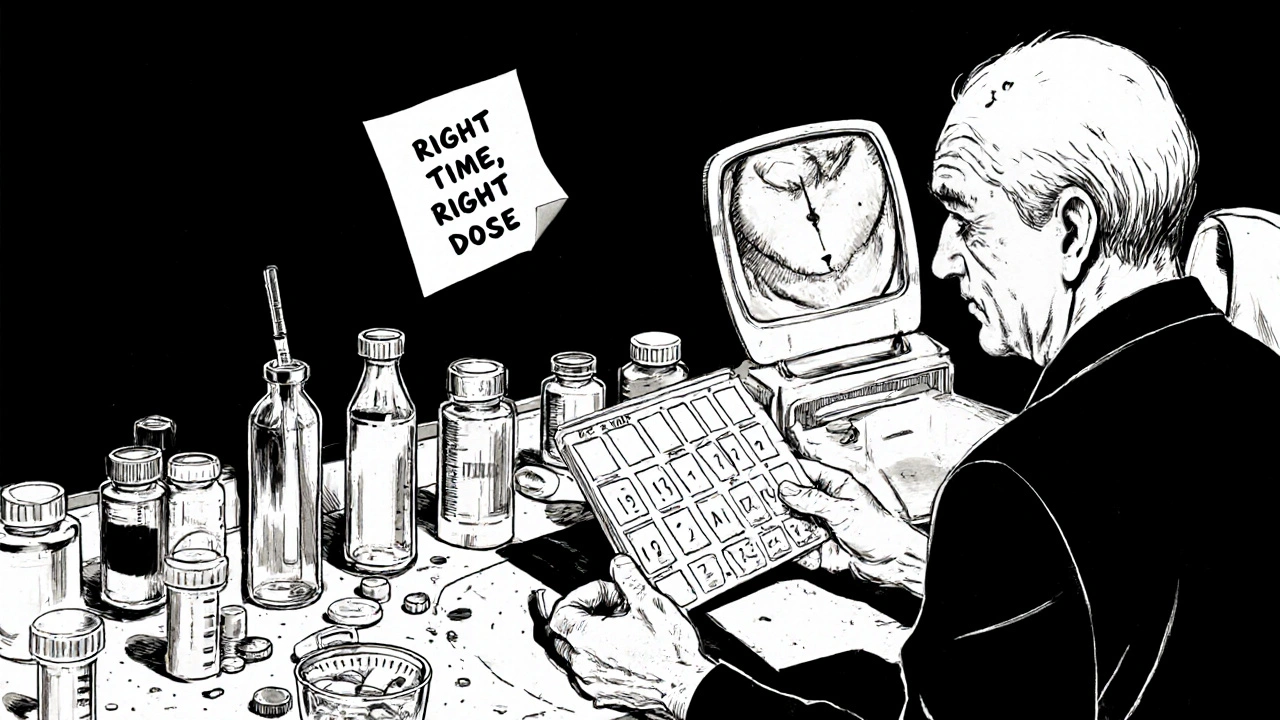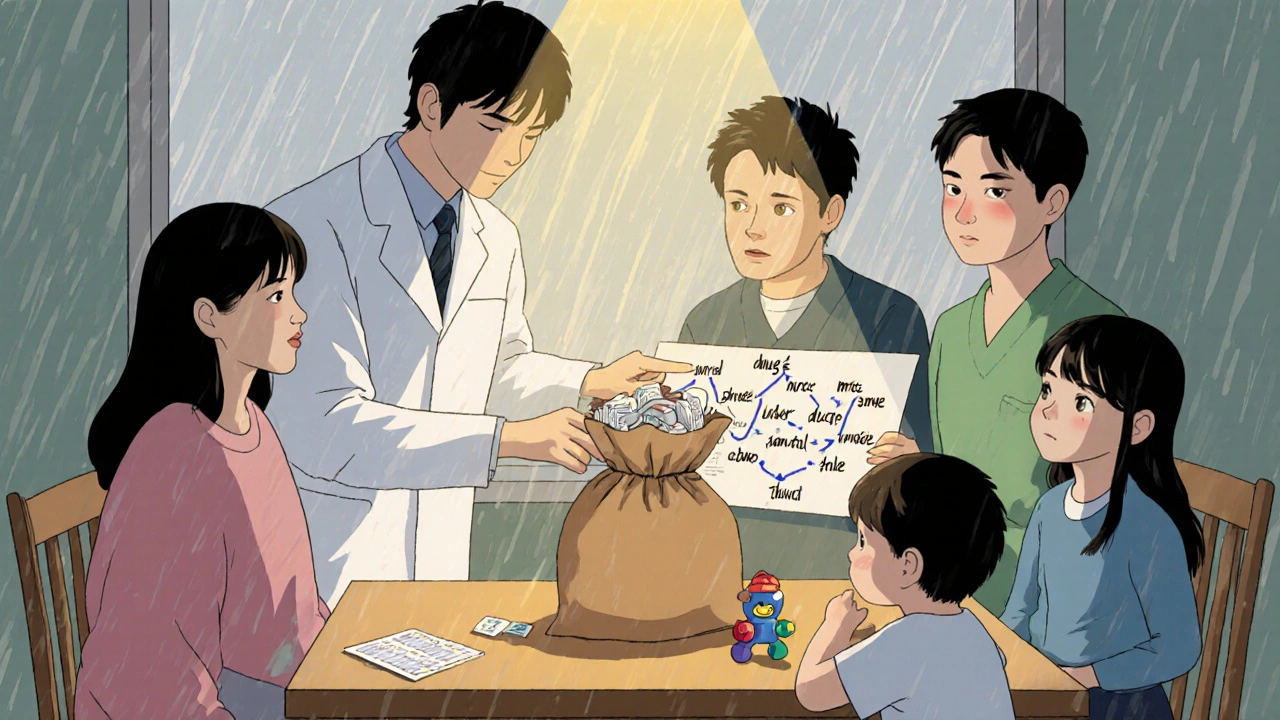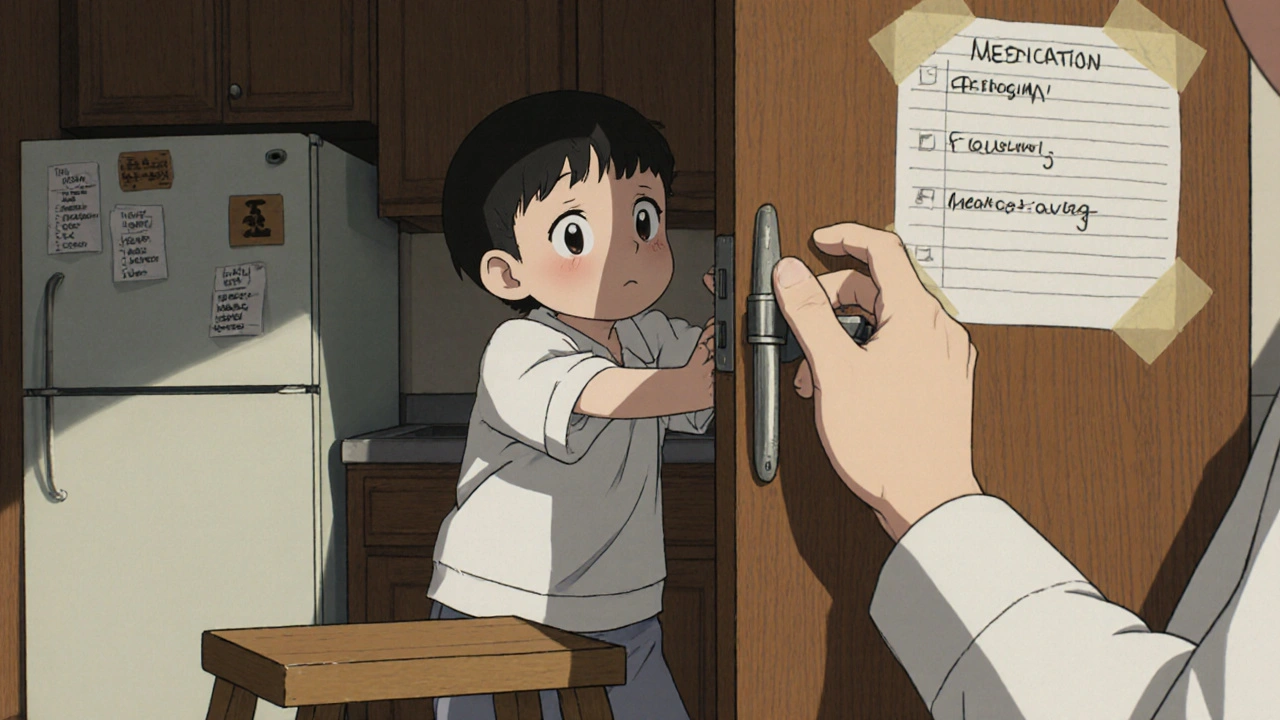Why Medication Safety at Home Matters More Than You Think
Every year, 1.9 million children under 6 end up in emergency rooms after swallowing medicine they weren’t supposed to. Most of these incidents happen not in hospitals, but right in your living room-on a counter, in a purse, or inside an unlocked cabinet. It’s not just kids either. Seniors taking five or more pills a day are at high risk for dangerous interactions, missed doses, or accidental overdoses. The truth is, if you have medications in your home, you already have a medication routine. The question is: is it safe?
Store Medications Up and Away-Not Just Out of Reach
Many parents think keeping medicine on a high shelf is enough. It’s not. Kids climb. They pull down bags, climb on chairs, and open drawers. According to Children’s Hospital Los Angeles, 25% of exposures happen when meds are left in purses or bags on counters. The real solution? Locked cabinets. Not just any cabinet-a real lock, like a childproof latch or a small lockbox. Keep everything: prescriptions, vitamins, cough syrup, even topical creams. If it’s a medicine, it needs to be locked up.
And don’t store meds in the bathroom. Humidity from showers and sinks can make pills lose their strength. The best place? A bedroom cabinet, kitchen upper shelf with a lock, or a dedicated medicine lockbox. The CDC’s Up and Away campaign found households that followed this rule saw a 34% drop in accidental ingestions.
Use the Five Rights Every Time You Give a Pill
Before you hand out any medication-whether it’s Tylenol for a fever or a heart pill for Grandpa-ask yourself these five questions:
- Right child? Is this medicine for the person you’re giving it to?
- Right medication? Does the label match what you’re supposed to give?
- Right dose? Are you using the measuring tool that came with it? A kitchen spoon? That’s risky.
- Right route? Is it meant to be swallowed, applied to the skin, or inhaled?
- Right time? Are you giving it at the exact time prescribed?
Getting one of these wrong can cause serious harm. A 2022 study showed that using an oral syringe instead of a cup for liquid meds cuts dosing errors by 47%. Always use the tool that came with the medicine. If you lost it, ask your pharmacist for a new one. They’re free.
Build a Master Medication List-No Exceptions
Write down every single thing your family takes. Not just prescriptions. Include:
- Over-the-counter pills (ibuprofen, antacids, allergy meds)
- Vitamins and supplements (fish oil, magnesium, melatonin)
- Herbal remedies (echinacea, turmeric, ginkgo)
- Topical creams and patches
For each item, write the name (brand and generic), dosage, how often it’s taken, why it’s prescribed, and when it was started. Keep a copy on the fridge. Give one to your doctor and pharmacist. Update it every time something changes.
Why? Because 68% of older adults take five or more medications daily. That’s a recipe for dangerous interactions. A brown bag review-where you bring all your meds to the pharmacy every six months-helps pharmacists spot duplicates, conflicts, or drugs that are no longer needed. The American Pharmacists Association says this simple step reduces adverse events by up to 30%.

Use Pill Organizers and Digital Helpers-But Know Their Limits
Seven-day pill boxes are a game-changer for families juggling multiple meds. They’re cheap, easy to use, and help prevent double-dosing. A 2023 AARP survey found 68% of caregivers who used them reported fewer mistakes.
But don’t rely on them alone. Some pills shouldn’t go in organizers-like those that degrade in light or moisture. Check with your pharmacist first.
For tech-savvy families, apps like Medisafe or MyTherapy send reminders and track doses. But here’s the catch: 27% of older adults abandon digital tools within three months because they’re too confusing. If your parent or grandparent isn’t comfortable with phones, stick with visual cues: color-coded tape on bottles, sticky notes on the fridge, or a simple printed chart.
Know the Signs of an Overdose-and Have Naloxone Ready
If you have opioids in the house-whether for pain after surgery or a chronic condition-you need to know the signs of overdose:
- Very small pupils
- Slow or shallow breathing
- Unresponsiveness or extreme drowsiness
Don’t wait. Call 911 immediately. But while you wait, use naloxone (Narcan). It’s safe, easy to use, and available over the counter in most states. Keep it near your meds. Train one other family member on how to use it. The CDC says having naloxone on hand can save a life within minutes.
Dispose of Old or Unused Meds the Right Way
Never flush pills down the toilet or toss them in the trash. That’s how they end up in water supplies or get found by kids or pets. The best way? Use a drug take-back program. Many pharmacies and police stations have drop boxes. If that’s not available, mix pills with coffee grounds or cat litter in a sealed bag before throwing them out. Remove labels or scratch them out to protect privacy.
Do this every six months. Clear out expired antibiotics, old painkillers, and those “just in case” meds you never used. Less clutter means less risk.
Review Medications with Your Doctor Every Six Months
Doctors don’t always know what you’re taking at home. That’s why the American Geriatrics Society recommends a deprescribing review for seniors. Up to 15% of hospital visits for older adults are caused by unnecessary or harmful meds. Anticholinergic drugs-common in sleep aids, allergy pills, and bladder meds-can increase fall risk by 50%. Ask your doctor: “Is this still needed? Can we reduce or stop it?”
For anyone on five or more medications, schedule a quarterly check-in with your pharmacist. Studies show this reduces adverse events by 27%.

What to Do If You Miss a Dose
It happens. You’re running late. The kid throws up the pill. You forget because you were distracted.
Don’t panic. Don’t double up. HealthyChildren.org says: “Give the missed dose as soon as you remember. Then go back to your normal schedule. Never give two doses at once.”
If it’s close to the next dose, skip the missed one. Never make up for it with extra. Too much can be dangerous.
Teach Your Kids-Without Scaring Them
Medicine isn’t candy. But telling a 3-year-old “don’t touch that” doesn’t work. Instead, teach them: “Medicine is for grown-ups only. If you’re not sure, ask Mom or Dad.” Make it part of your daily routine, like crossing the street. Use simple language. Show them the locked cabinet. Let them help you open it when it’s time for their own medicine. Knowledge reduces curiosity.
Emergency Prep: Know the Poison Control Number
Only 35% of households keep a current medication list. Only 40% know the Poison Control number: 1-800-222-1222.
Save it in your phone. Write it on the fridge. Put it on the back of your medicine cabinet door. If you ever suspect someone swallowed something they shouldn’t, call immediately. Don’t wait for symptoms. Don’t try to make them throw up. Just call. Poison Control gives you step-by-step instructions in seconds.
Start Small. Build the Routine.
You don’t need to fix everything tomorrow. Pick one thing to start:
- Lock your medicine cabinet this week.
- Write down your family’s meds by Friday.
- Buy a pill organizer for the person who forgets doses.
It takes 2-3 weeks to build a new habit. Once you do, you’ll feel calmer. You’ll sleep better. And your family will be safer.
What should I do if my child swallows medicine by accident?
Call Poison Control immediately at 1-800-222-1222. Do not wait for symptoms. Do not try to make them vomit. Have the medicine container ready when you call so you can tell them the name, dose, and time it was taken. Keep the number saved in your phone and posted on the fridge.
Can I store all my meds in one place?
Yes-but only if it’s locked and away from children and pets. Don’t mix prescription drugs with vitamins or OTC meds unless they’re all stored in the same secure container. Keep them organized by person and purpose. Use labeled compartments or separate boxes to avoid confusion.
Are pill organizers safe for all medications?
Not all. Some pills, like sublingual tablets or capsules that break down in air, shouldn’t be removed from their original packaging. Check with your pharmacist. Also, avoid putting meds in organizers that are exposed to heat or moisture-like near the sink or in a car.
How often should I clean out my medicine cabinet?
Every six months. Check expiration dates. Discard anything you haven’t used in over a year. Throw away pills that smell strange, look discolored, or are cracked. Use a drug take-back program or mix them with coffee grounds in a sealed bag before tossing.
Is it safe to give adult medicine to a child if I cut the dose?
No. Adult and children’s medicines are formulated differently. Even if you cut a pill, the inactive ingredients may not be safe for kids. Always use medicine made for children and follow the dosing chart by weight or age. If you’re unsure, ask your pharmacist.
What’s the biggest mistake families make with medications?
Leaving meds unlocked and untracked. The most common error isn’t giving the wrong dose-it’s not knowing what’s in the house. Half of all medication exposures happen because families don’t have a clear list of what’s being taken, where it’s stored, or who’s responsible for giving it.


Brandon Trevino
November 27, 2025 AT 16:40Also, 'up and away' is a misleading slogan. Children don't climb shelves; they climb caregivers. The real solution is behavioral conditioning + environmental design, not just locks.
Denise Wiley
November 29, 2025 AT 02:25Skye Hamilton
November 30, 2025 AT 11:57Maria Romina Aguilar
December 1, 2025 AT 08:01Hannah Magera
December 2, 2025 AT 19:01Austin Simko
December 3, 2025 AT 10:52Nicola Mari
December 4, 2025 AT 13:44Sam txf
December 5, 2025 AT 13:50George Hook
December 5, 2025 AT 20:17jaya sreeraagam
December 6, 2025 AT 09:11Katrina Sofiya
December 7, 2025 AT 11:38kaushik dutta
December 8, 2025 AT 19:06doug schlenker
December 9, 2025 AT 00:31Olivia Gracelynn Starsmith
December 9, 2025 AT 04:16Gus Fosarolli
December 10, 2025 AT 15:43